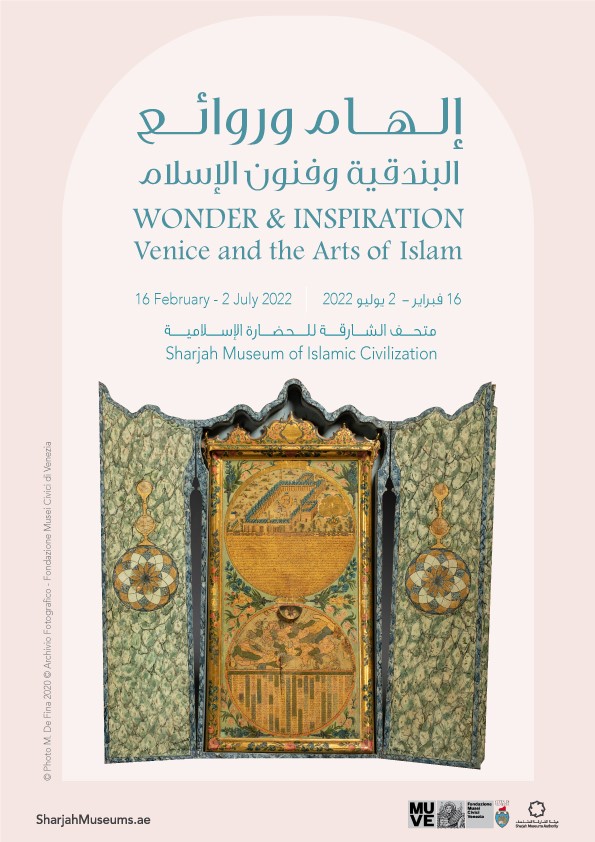Museum of Islamic Civilization
Emirate of Sharjah
From 16 February to 2 July 2022
Scientific Direction Gabriella Belli
Curated by Andrea Bellieni
with Valeria Cafà, Cristina Crisafulli, Gabriele Paglia, Chiara Squarcina, Monica Viero
 The exhibition WONDER & INSPIRATION. Venice and the Arts of Islam opens on 16 February at the Sharjah Museum of Islamic Civilization.
The exhibition WONDER & INSPIRATION. Venice and the Arts of Islam opens on 16 February at the Sharjah Museum of Islamic Civilization.
It presents a selection from the rich collection of works of art and documents preserved by the Fondazione Musei Civici di Venezia and aims to demonstrate the intensity and the profitability of the cultural and artistic exchanges between Venice and the Islamic culture along a chronological period between the Middle Ages and the modern age.
Venice, as Venus born from the water – actually, in the water! – and for this reason absolutely unique, founded its millennial civilization above all on ideals of dialogue and exchange “on and along the water”, mainly with the places and other communities and cultures with which Venice entered into dialogue for trading reasons. Therefore, already before the year 1000, the merchants of Venice were actively operating in all the centres, cities and mercantile emporiums, flourishing along the coasts of the entire Mediterranean Sea, both towards the East, between Egypt and Turkey, and towards the South (Sicily Arab and North Africa), and to the West (Moorish Spain). Moreover, from the 13th century they were also present along the ‘Silk way’ (the long road to China and the Far East), therefore in the heart of the Middle East, along the caravan routes that reached the shore of the Caspian Sea, or that crossed the Tigris and Euphrates rivers.
Through these extensive commercial relationships, while silk and spices were fundamental, also the highly refined products of art and craftsmanship made in the regions of the Mediterranean and the East, were exchanged: the Republic of Venice was for many centuries a ‘bridge’ between East and West.
Among the determining factors of the Venetian success and its peculiar and unique role, there were certainly its great seafaring experience, its financial strength, its organization of the “fondaci” (warehouses) and its great religious tolerance.
For all these reasons the characteristic qualities of the Venetian citizen, resourceful and courageous, were his openness and curiosity for all the cultures with which he was in contact; a man always willing to be caught by the “WONDER”, aroused in him by the achievements of the extraordinary Art of Islam, an art precious and refined, amazing for its imagination, characterized by the decorative ability, as well as by the prodigious techniques which made noble the most common materials, or exalted the extraordinary qualities of the precious ones.
This is the reason for which the houses of Venetian merchants soon became filled with these exceptional “objects of wonder”. The events of history have meant that some of these works, especially at the time of the fall of the Venetian Republic (1797), passed directly from the houses to the Museum: they are the same objects that this exhibition displays. They are also the same works that in Venice, in a very long time span reaching the eighteenth century, stimulated the “INSPIRATION” to the taste, the invention and the technical ability of the Venetian artists and artisans: not mere imitations, but original creations born from that living suggestion, sometimes faithfully reproduced in the motifs, sometimes reworked with freedom.
The most characteristic ‘Venetian style’ was born from those ‘Islamic’ sources, only apparently distant, rich, gilded and sumptuous, characterized by stylized decorative motifs that looks at nature or based on a complex interwoven geometry, by a refined but also bright chord of colours, the precious quality of the material: these are all elements that closely link the art of Venice to that of the cultures of the Mediterranean and the Silk Road.